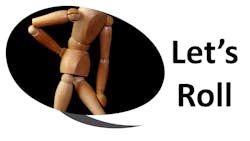An estimated 50 million of us suffer from some type of chronic pain, according to new finding from the Centers for Disease Control and Prevention. If you haven’t used a foam roller at the gym or at home, you’re missing out on a simple way to ease that pain and loosen tight muscles. Foam rolling is very effective and much cheaper than a massage. However, there is a right way to use a foam roller to ensure you don’t aggravate an aching muscle or even injure yourself. Foam rollers are great for stretching muscles and for breaking down scar tissue and soft tissue adhesions. Think of it as performing a self-massage resulting in easing trigger points and increasing circulation.
How to use a foam roller
To begin with you’ll need to find a space slightly larger than your supine body. Place the foam roller beneath your body as you lie on it face up. The weight of your body creates the pressure needed to release tight spots in the fascia, the soft connective tissue located just below the skin that wraps and connects the muscles, bones, nerves and blood vessels of the body. When you haven’t exercised in a while, haven’t stretched, or you’ve been injured, the fascia can stick to the muscle tissue causing an adhesion that restricts muscle movement, causes pain, and reduces flexibility. If you’ve ever had shin splint pain or IT band syndrome, you’ll know what I mean.
By the way, it’s always a good idea to check with your doctor or certified trainer before using a foam roller. Always work with the roller when your muscles are warm, like after a workout. Place the roller beneath the soft tissue area you’d like to release, then gently roll your body weight back and forth across the roller, targeting the affected muscle. (You control the amount of pressure by applying more or less body weight on the roller by using your hands and feet to offset your weight as needed). Slow movements are recommended and if you find a painful area (trigger point) hold that position until the area softens.
Try to concentrate on the areas that are tight and have limited range of motion, then roll over those areas a few times until you feel it soften. You may feel some pain to begin with, but with repeated treatment it will subside. Slowly roll the targeted area until you find the most painful or tender spot, then hold that spot for 30-90 seconds while you relax the targeted area and the tenderness subsides. Maintain your core stability while performing the movements.
Don’t roll over bones or joints, focus on soft tissue. Also, foam roller sessions should be no longer than 15 minutes. Rest a day in between sessions starting out and hydrate with water after a session. After several weeks you may feel more comfortable with increasing the time and frequency of your roller sessions.
Use caution when rolling the back
Many of us who work out will occasionally experience back pain. Even those folks that don’t exercise get back pain from things like driving all day, sitting in front of a computer screen for eight hours, or being on your feet preparing food, etc. Foam rollers are a great way to alleviate the resulting pain and discomfort but be advised that done improperly, you risk injury or exacerbating existing pain. For upper back: lie on the foam roller on the upper back with your knees bent. Put your hands behind your head and bring your elbows together until they point to the ceiling. Tighten your core while lifting your hips slightly off the floor, then slowly roll down your upper back stopping just below the shoulder blades. Try to curl your trunk forward as you roll so that your back is heavy into the roller.
For lower back: lie sideways on the foam roller and slowly roll back and forth to release the muscles along the sides of your low back. Repeat on both sides. You can also try rolling your glutes and piriformis, the muscles in your butt, or experiment using smaller objects such as a tennis ball.
Foam rollers are available at most sporting goods stores and are quite inexpensive. They also come in a variety of sizes and softness. The latest style foam roller, called the Grid Foam Roller, has a unique design that targets trigger points. The smaller size, about 13” X 5” makes it more portable than traditional rollers. It is slightly more expensive than the standard foam rollers.
If you’ve experienced back pain and haven’t tried foam rollers, I think it might just be the answer to easing your pain. It’s cheaper than a doctor visit or massage session and it’s available whenever you need it. Why not give it a shot?
Stay Safe, Brothers and Sisters!



